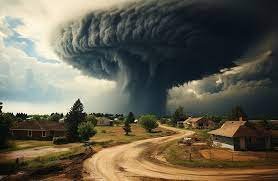Why in the News?
Darjeeling, known for its beauty and climate, has faced multiple natural disasters (like landslides and floods) in recent years, including October 2025’s extreme rainfall event that collapsed Dudhia Bridge, disrupting key roads between Siliguri and Mirik, highlighting India’s need for a multi-faceted approach to manage its diverse hazards (like heat related challenges and extreme rainfall events) effectively.
What is a hazard and a disaster?
- A hazard is a natural or human-made event with the potential to cause harm to people, property, or the environment.
- A disaster occurs when a hazard actually causes severe damage, loss of life, or environmental degradation that exceeds a community’s capacity to cope, impacting the vulnerable populations.
What are the causes of increasing disasters?
- Population Pressure and Unregulated Urbanization: Migration (from plains and neighboring countries) and unchecked land buying have exceeded the hills’ carrying capacity, blocked drainage, and weakened slopes, heightening landslide and flood risks.
- Climate Change and Altered Rainfall Patterns: Steady monsoons have turned into short, intense downpours, making the terrain more unstable.
- Hydrological Instability: Rivers and streams are altering course, flooding and eroding settlements.
- Unsustainable Development Projects: Hydropower, rail, and tourism projects on fragile slopes strain ecology and amplify disaster vulnerability.
What impacts do these increasing disasters have?
- Social: Leads to loss of life, injuries, displacement, and long-term health risks, especially for vulnerable groups like children, the elderly, and marginalized communities.
- Economic: Damage to agriculture, infrastructure, tourism, and livelihoods.
- Environmental: Soil erosion, deforestation, river siltation, biodiversity loss.
- Strategic: Disruption of border areas and critical infrastructure.
What steps have been taken by the Government for Disaster Management?
- Institutional Framework:
- The Ministry of Home Affairs (MHA) and the National Disaster Management Authority (NDMA) oversee both pre- and post-disaster phases.
- It is guided by PM’s Ten-Point Agenda on Disaster Risk Reduction (2016).
- It offers a holistic approach to managing disaster risk. It integrates preparedness across all levels of society by emphasizing inclusive policies, leveraging technology, building local capacity, and fostering international cooperation.
- Established inter-ministerial and Centre-State committees to oversee implementation of policies.
- Disaster Risk Reduction (DRR) and Funding
- The 15th Finance Commission in 2021, allocated around $30 billion over 5 years for DRR, covering prevention, mitigation, preparedness, capacity building, and post–disaster reconstruction.
- Distribution of Funds: 10% to Preparedness/ Capacity Building, 20% to mitigation, 40% to post-disaster response and 30% to reconstruction.
- Five priority areas for nature-based DRR:
- Identify Risks: Find and prioritise the most dangerous hazards.
- Science-Based Planning: Use scientific methods for mitigation and reconstruction.
- Avoid Overlap: Make sure new programmes don’t repeat existing ones.
- Better Coordination: Improve cooperation between Centre, States, and ministries.
- Simple Rules: Keep regulations practical and easy to follow.
- Capacity Building
- Created 2 volunteer groups (approx 2.5 volunteers) – Apda Mitra and Yuva Apda Mitra
- Established geo-spatial training labs and action based research at National Institute of Disaster Management (NIDM).
- NIDM now has a 36-stream disaster management course to mainstream training down to the panchayat level.
- Mitigation Projects
- National Cyclone Mitigation Programme (2011–22) successfully reduced coastal vulnerability through early warning systems, cyclone shelters, and embankments.
- The government aims to prioritize nature-based solutions to address climate change and extreme weather. NDMA also urges States and urban authorities to:
- Rejuvenate water bodies and green spaces to prevent urban floods.
- Use remote sensing and automated weather stations to monitor glacial lakes.
- Apply bio-engineering for slope stabilisation in landslide-prone zones.
- Revive beels (water bodies) along the Brahmaputra and implement fire prevention measures.
- Early warning Systems
- The government has developed advanced early warning systems for multiple hazards, reducing casualties.
- The Common Alerting Protocol provides timely alerts in regional languages. Community capacity is strengthened through a network of universities and various training programmes.
- Mock drills, hazard-specific awareness campaigns, and school safety programs further prepare citizens for disasters.
- International Cooperation:
- India coordinates internationally to learn and share knowledge on disaster risk reduction.
- It created the Coalition for Disaster Resilient Infrastructure (CDRI) and leads initiatives at G20, SCO, BIMSTEC, and IORA.
Challenges and Way Forward
| Challenges | Way Forward |
| Weak local institutions and disaster management units | Strengthen local units with trained personnel, emergency funds, and clear responsibilities |
| Unplanned urbanisation and encroachment on hill slopes | Enforce strict land-use zoning and protect eco-sensitive areas |
| Unsustainable tourism and infrastructure development | Implement eco-tourism guidelines and assess carrying capacity before projects |
| Ignored scientific warnings and lack of preparedness | Use regular early warning systems, community drills, and awareness campaigns |
| Construction on fragile slopes increasing landslide and flood risk | Ban construction on fragile hilltops and conduct scientific risk assessments for new projects |
Conclusion
While India faces natural hazards, most recent disasters are increasingly human-induced, driven by population pressure, unplanned urbanisation, and unsustainable development. Strengthened institutional frameworks, early warning systems, and community engagement are crucial, but a holistic, science-based, and nature-oriented approach is essential to reduce vulnerability, protect lives, and safeguard the environment.
| Ensure IAS Mains Question Q. Critically analyse the factors contributing to the increasing frequency and intensity of disasters in India. Suggest measures to enhance disaster resilience, focusing on institutional frameworks, early warning systems, and sustainable development. (250 words) |
| Ensure IAS Prelims Question Q. Consider the following statements regarding disaster management in India: 1. The National Disaster Management Authority (NDMA) oversees both pre- and post-disaster phases. 2. The 15th Finance Commission allocated around $30 billion over 5 years for disaster risk reduction. Which of the statements given above is/are correct? a) 1 only b) 2 only c) Both 1 and 2 d) Neither 1 nor 2 Answer: c) Both 1 and 2 Explanation: Statement 1 is correct: NDMA, under the Ministry of Home Affairs, manages disaster preparedness, mitigation, response, and recovery, covering both pre- and post-disaster phases. Statement 2 is correct: The 15th Finance Commission (2021) allocated approximately $30 billion over five years to strengthen disaster risk reduction, including preparedness, mitigation, response, and reconstruction efforts. |
Also Read | |
| UPSC Foundation Course | UPSC Daily Current Affairs |
| UPSC Monthly Magazine | CSAT Foundation Course |
| Free MCQs for UPSC Prelims | UPSC Test Series |
| ENSURE IAS NOTES | Our Booklist |





